Dissertation: Technology's Effect on Environmental Sustainability
VerifiedAdded on 2020/04/15
|67
|15245
|496
Thesis and Dissertation
AI Summary
This dissertation investigates the impact of technology on environmental sustainability, with GHD New Zealand as a case study. The study examines the factors contributing to environmental sustainability, the role of technology in enhancing sustainable development, and the practices of GHD. Data was collected through a survey of 50 employees and interviews with three managers, analyzed using quantitative and qualitative methods. The findings highlight the importance of environmental sustainability and the significant role of technology. The research identifies the elements of environmental sustainability, assesses the significance of these factors, examines the impact of technology, and recommends improvements. The dissertation concludes with recommendations for future research and development in the field.
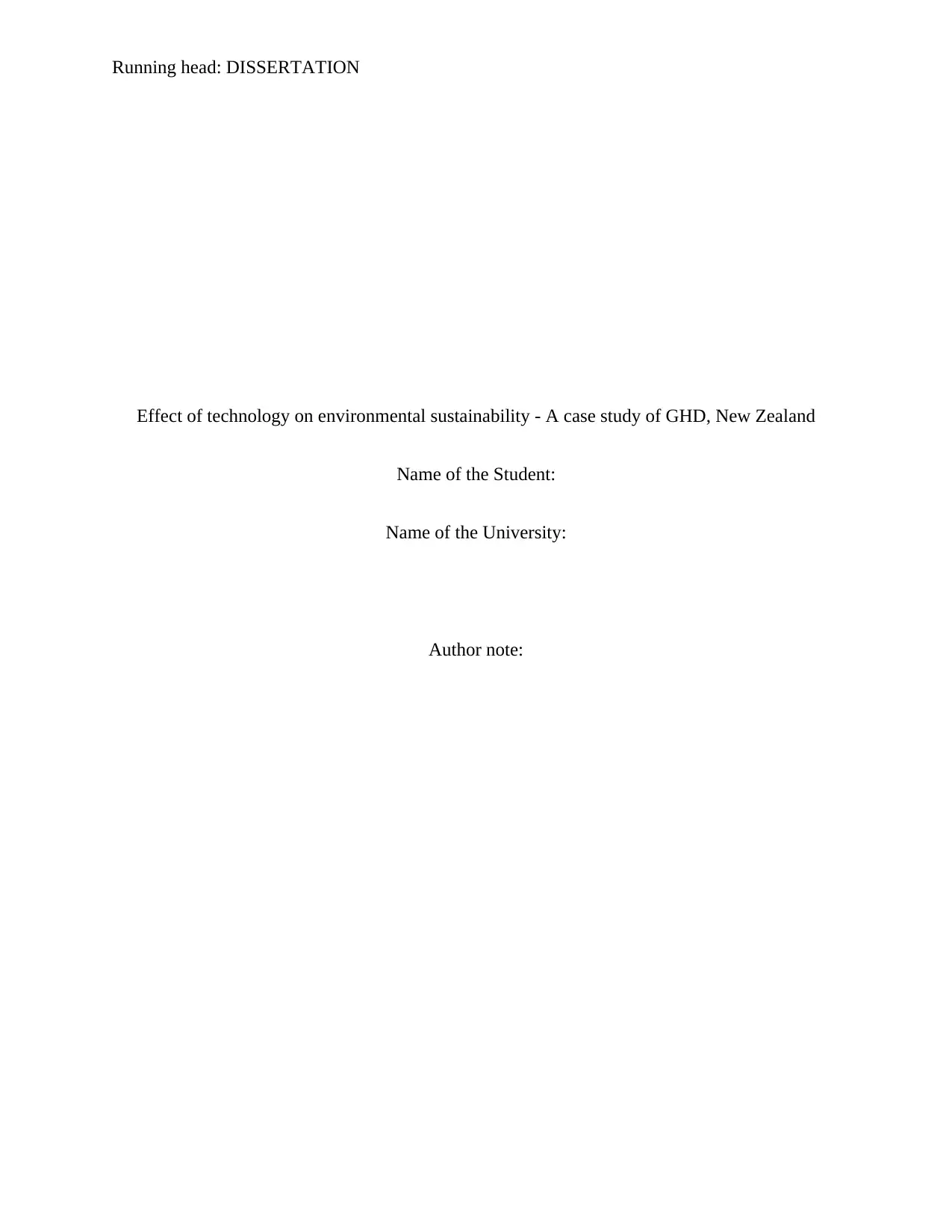
Running head: DISSERTATION
Effect of technology on environmental sustainability - A case study of GHD, New Zealand
Name of the Student:
Name of the University:
Author note:
Effect of technology on environmental sustainability - A case study of GHD, New Zealand
Name of the Student:
Name of the University:
Author note:
Paraphrase This Document
Need a fresh take? Get an instant paraphrase of this document with our AI Paraphraser

1DISSERTATION
Acknowledgement
I would like to express my gratitude towards all the people who had guided me in every way
possible to complete my dissertation. These people had helped me to know my strength and
potential and use it in the best manner to undertake the research study. I would also like to
convey my gratitude towards my supervisor for the continuous monitoring and excellent
guidance, which has helped me to complete my study in proper time. The unconditional support
and guidance provided by my supervisor has not only helped me with the study but will also help
me throughout my life for other purposes also. I would also like to show appreciation for all the
respondents who spent their precious time to fill up the survey form and gave me interviews
regarding the research topic. Lastly, I express my gratitude to my friends and family, who lent
me a constant encouragement and support for completing my study.
Acknowledgement
I would like to express my gratitude towards all the people who had guided me in every way
possible to complete my dissertation. These people had helped me to know my strength and
potential and use it in the best manner to undertake the research study. I would also like to
convey my gratitude towards my supervisor for the continuous monitoring and excellent
guidance, which has helped me to complete my study in proper time. The unconditional support
and guidance provided by my supervisor has not only helped me with the study but will also help
me throughout my life for other purposes also. I would also like to show appreciation for all the
respondents who spent their precious time to fill up the survey form and gave me interviews
regarding the research topic. Lastly, I express my gratitude to my friends and family, who lent
me a constant encouragement and support for completing my study.
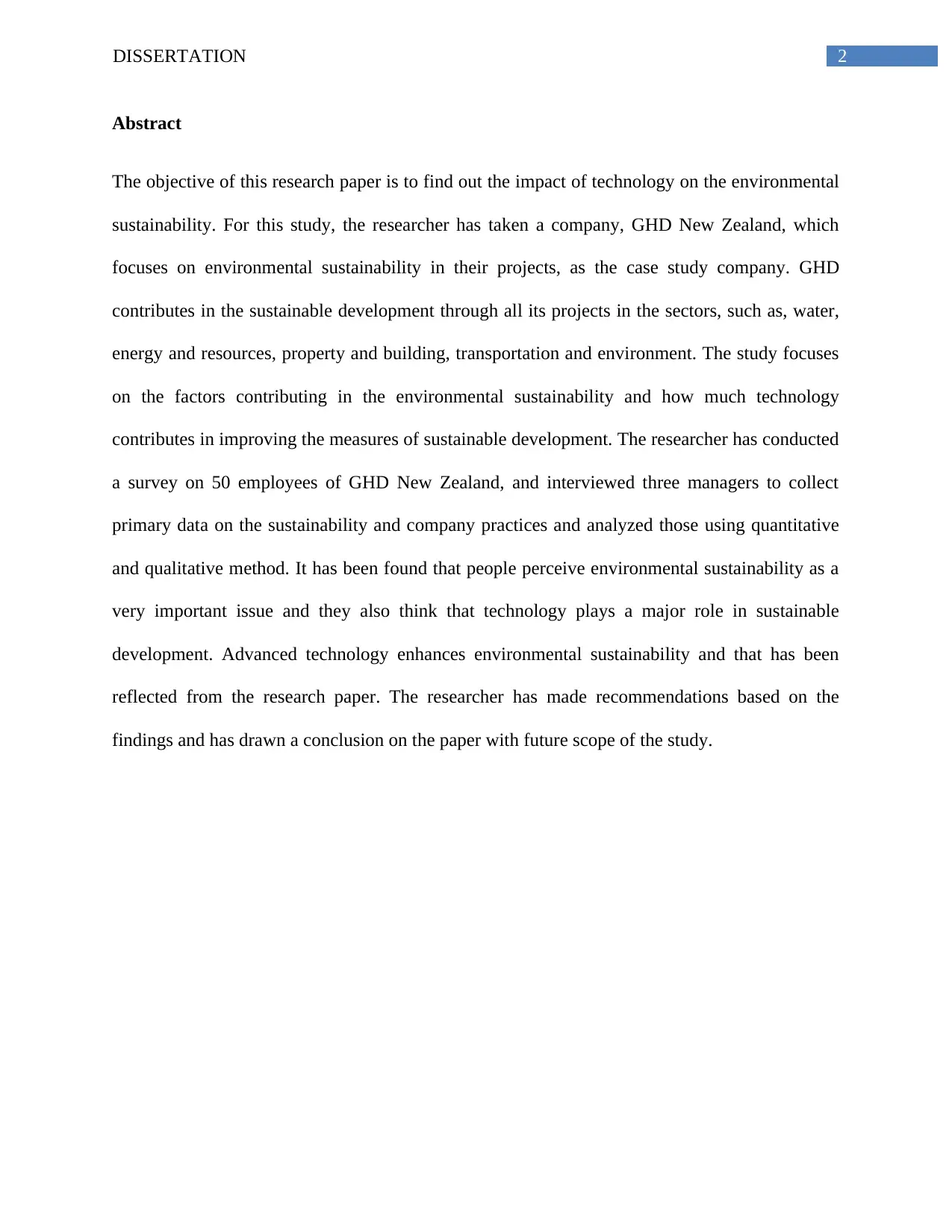
2DISSERTATION
Abstract
The objective of this research paper is to find out the impact of technology on the environmental
sustainability. For this study, the researcher has taken a company, GHD New Zealand, which
focuses on environmental sustainability in their projects, as the case study company. GHD
contributes in the sustainable development through all its projects in the sectors, such as, water,
energy and resources, property and building, transportation and environment. The study focuses
on the factors contributing in the environmental sustainability and how much technology
contributes in improving the measures of sustainable development. The researcher has conducted
a survey on 50 employees of GHD New Zealand, and interviewed three managers to collect
primary data on the sustainability and company practices and analyzed those using quantitative
and qualitative method. It has been found that people perceive environmental sustainability as a
very important issue and they also think that technology plays a major role in sustainable
development. Advanced technology enhances environmental sustainability and that has been
reflected from the research paper. The researcher has made recommendations based on the
findings and has drawn a conclusion on the paper with future scope of the study.
Abstract
The objective of this research paper is to find out the impact of technology on the environmental
sustainability. For this study, the researcher has taken a company, GHD New Zealand, which
focuses on environmental sustainability in their projects, as the case study company. GHD
contributes in the sustainable development through all its projects in the sectors, such as, water,
energy and resources, property and building, transportation and environment. The study focuses
on the factors contributing in the environmental sustainability and how much technology
contributes in improving the measures of sustainable development. The researcher has conducted
a survey on 50 employees of GHD New Zealand, and interviewed three managers to collect
primary data on the sustainability and company practices and analyzed those using quantitative
and qualitative method. It has been found that people perceive environmental sustainability as a
very important issue and they also think that technology plays a major role in sustainable
development. Advanced technology enhances environmental sustainability and that has been
reflected from the research paper. The researcher has made recommendations based on the
findings and has drawn a conclusion on the paper with future scope of the study.
⊘ This is a preview!⊘
Do you want full access?
Subscribe today to unlock all pages.

Trusted by 1+ million students worldwide
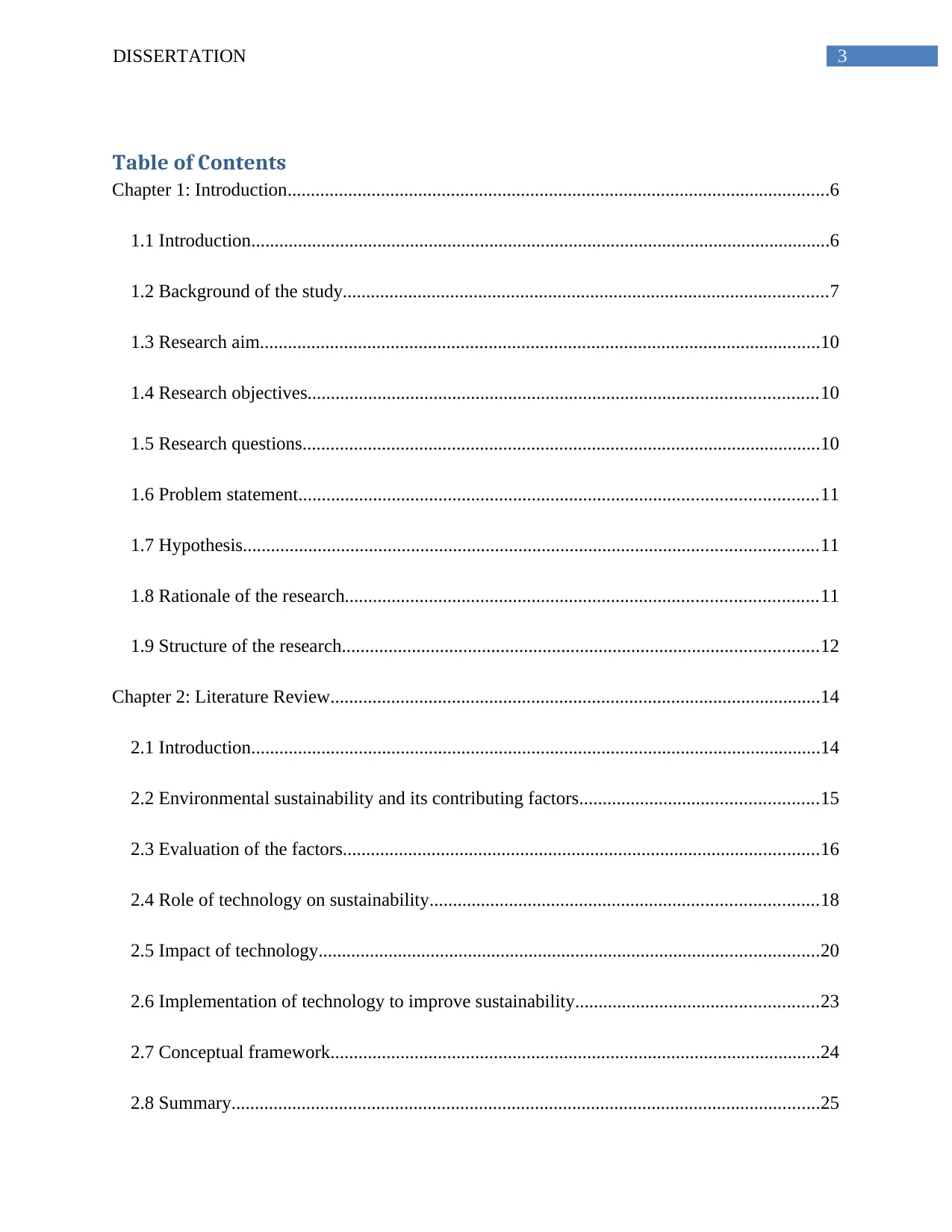
3DISSERTATION
Table of Contents
Chapter 1: Introduction....................................................................................................................6
1.1 Introduction............................................................................................................................6
1.2 Background of the study........................................................................................................7
1.3 Research aim........................................................................................................................10
1.4 Research objectives.............................................................................................................10
1.5 Research questions...............................................................................................................10
1.6 Problem statement...............................................................................................................11
1.7 Hypothesis...........................................................................................................................11
1.8 Rationale of the research.....................................................................................................11
1.9 Structure of the research......................................................................................................12
Chapter 2: Literature Review.........................................................................................................14
2.1 Introduction..........................................................................................................................14
2.2 Environmental sustainability and its contributing factors...................................................15
2.3 Evaluation of the factors......................................................................................................16
2.4 Role of technology on sustainability...................................................................................18
2.5 Impact of technology...........................................................................................................20
2.6 Implementation of technology to improve sustainability....................................................23
2.7 Conceptual framework.........................................................................................................24
2.8 Summary..............................................................................................................................25
Table of Contents
Chapter 1: Introduction....................................................................................................................6
1.1 Introduction............................................................................................................................6
1.2 Background of the study........................................................................................................7
1.3 Research aim........................................................................................................................10
1.4 Research objectives.............................................................................................................10
1.5 Research questions...............................................................................................................10
1.6 Problem statement...............................................................................................................11
1.7 Hypothesis...........................................................................................................................11
1.8 Rationale of the research.....................................................................................................11
1.9 Structure of the research......................................................................................................12
Chapter 2: Literature Review.........................................................................................................14
2.1 Introduction..........................................................................................................................14
2.2 Environmental sustainability and its contributing factors...................................................15
2.3 Evaluation of the factors......................................................................................................16
2.4 Role of technology on sustainability...................................................................................18
2.5 Impact of technology...........................................................................................................20
2.6 Implementation of technology to improve sustainability....................................................23
2.7 Conceptual framework.........................................................................................................24
2.8 Summary..............................................................................................................................25
Paraphrase This Document
Need a fresh take? Get an instant paraphrase of this document with our AI Paraphraser
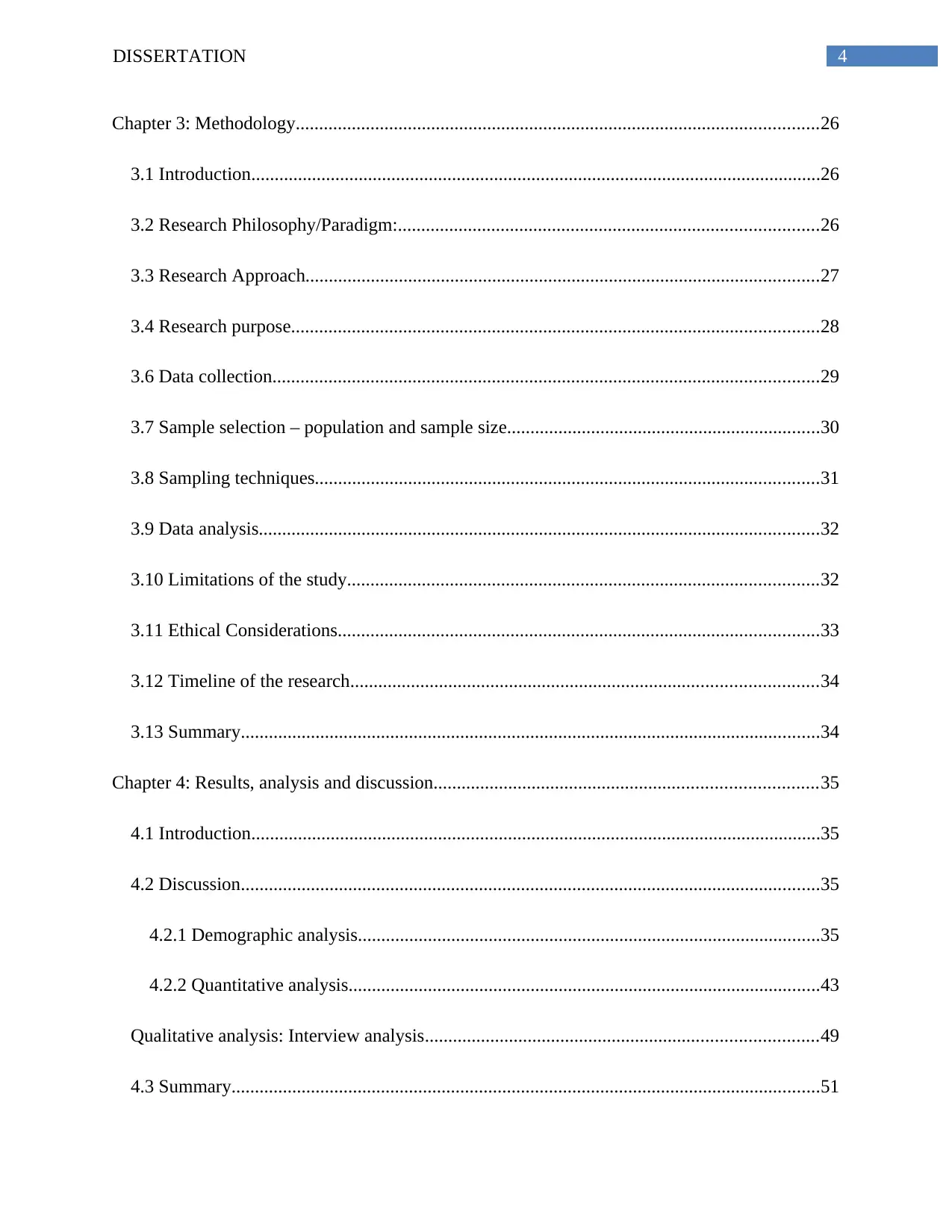
4DISSERTATION
Chapter 3: Methodology................................................................................................................26
3.1 Introduction..........................................................................................................................26
3.2 Research Philosophy/Paradigm:..........................................................................................26
3.3 Research Approach..............................................................................................................27
3.4 Research purpose.................................................................................................................28
3.6 Data collection.....................................................................................................................29
3.7 Sample selection – population and sample size...................................................................30
3.8 Sampling techniques............................................................................................................31
3.9 Data analysis........................................................................................................................32
3.10 Limitations of the study.....................................................................................................32
3.11 Ethical Considerations.......................................................................................................33
3.12 Timeline of the research....................................................................................................34
3.13 Summary............................................................................................................................34
Chapter 4: Results, analysis and discussion..................................................................................35
4.1 Introduction..........................................................................................................................35
4.2 Discussion............................................................................................................................35
4.2.1 Demographic analysis...................................................................................................35
4.2.2 Quantitative analysis.....................................................................................................43
Qualitative analysis: Interview analysis....................................................................................49
4.3 Summary..............................................................................................................................51
Chapter 3: Methodology................................................................................................................26
3.1 Introduction..........................................................................................................................26
3.2 Research Philosophy/Paradigm:..........................................................................................26
3.3 Research Approach..............................................................................................................27
3.4 Research purpose.................................................................................................................28
3.6 Data collection.....................................................................................................................29
3.7 Sample selection – population and sample size...................................................................30
3.8 Sampling techniques............................................................................................................31
3.9 Data analysis........................................................................................................................32
3.10 Limitations of the study.....................................................................................................32
3.11 Ethical Considerations.......................................................................................................33
3.12 Timeline of the research....................................................................................................34
3.13 Summary............................................................................................................................34
Chapter 4: Results, analysis and discussion..................................................................................35
4.1 Introduction..........................................................................................................................35
4.2 Discussion............................................................................................................................35
4.2.1 Demographic analysis...................................................................................................35
4.2.2 Quantitative analysis.....................................................................................................43
Qualitative analysis: Interview analysis....................................................................................49
4.3 Summary..............................................................................................................................51

5DISSERTATION
Chapter 5: Conclusion and recommendation.................................................................................53
5.1 Introduction..........................................................................................................................53
5.2 Linking to the objectives.....................................................................................................53
5.2.1 Linking to the first objective.........................................................................................53
5.2.2 Linking to the second objective....................................................................................54
5.2.3 Linking to the third objective.......................................................................................55
5.2.4 Linking to the fourth objective.....................................................................................56
5.3 Recommendation.................................................................................................................56
5.4 Future scope of the study.....................................................................................................57
References......................................................................................................................................58
Appendix........................................................................................................................................64
Chapter 5: Conclusion and recommendation.................................................................................53
5.1 Introduction..........................................................................................................................53
5.2 Linking to the objectives.....................................................................................................53
5.2.1 Linking to the first objective.........................................................................................53
5.2.2 Linking to the second objective....................................................................................54
5.2.3 Linking to the third objective.......................................................................................55
5.2.4 Linking to the fourth objective.....................................................................................56
5.3 Recommendation.................................................................................................................56
5.4 Future scope of the study.....................................................................................................57
References......................................................................................................................................58
Appendix........................................................................................................................................64
⊘ This is a preview!⊘
Do you want full access?
Subscribe today to unlock all pages.

Trusted by 1+ million students worldwide
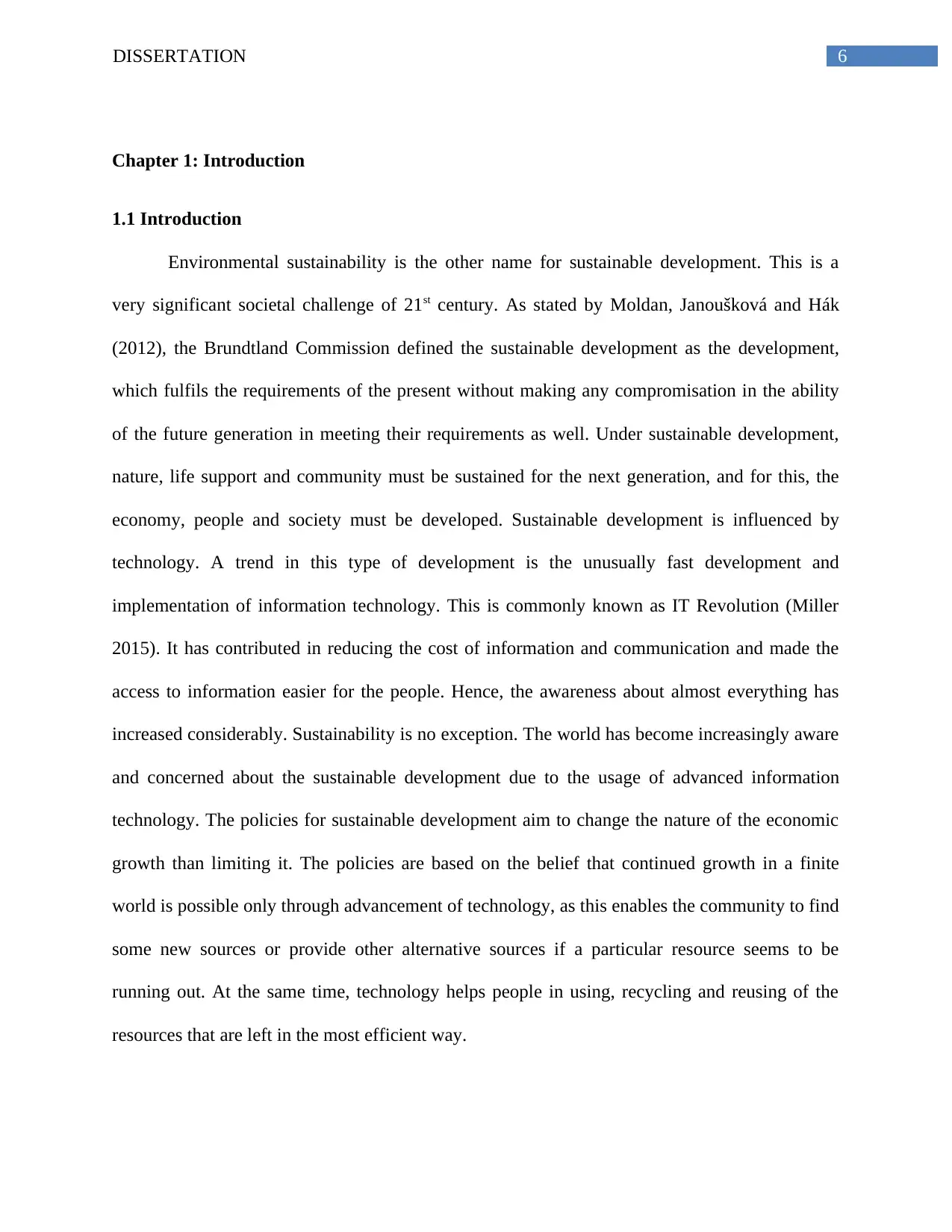
6DISSERTATION
Chapter 1: Introduction
1.1 Introduction
Environmental sustainability is the other name for sustainable development. This is a
very significant societal challenge of 21st century. As stated by Moldan, Janoušková and Hák
(2012), the Brundtland Commission defined the sustainable development as the development,
which fulfils the requirements of the present without making any compromisation in the ability
of the future generation in meeting their requirements as well. Under sustainable development,
nature, life support and community must be sustained for the next generation, and for this, the
economy, people and society must be developed. Sustainable development is influenced by
technology. A trend in this type of development is the unusually fast development and
implementation of information technology. This is commonly known as IT Revolution (Miller
2015). It has contributed in reducing the cost of information and communication and made the
access to information easier for the people. Hence, the awareness about almost everything has
increased considerably. Sustainability is no exception. The world has become increasingly aware
and concerned about the sustainable development due to the usage of advanced information
technology. The policies for sustainable development aim to change the nature of the economic
growth than limiting it. The policies are based on the belief that continued growth in a finite
world is possible only through advancement of technology, as this enables the community to find
some new sources or provide other alternative sources if a particular resource seems to be
running out. At the same time, technology helps people in using, recycling and reusing of the
resources that are left in the most efficient way.
Chapter 1: Introduction
1.1 Introduction
Environmental sustainability is the other name for sustainable development. This is a
very significant societal challenge of 21st century. As stated by Moldan, Janoušková and Hák
(2012), the Brundtland Commission defined the sustainable development as the development,
which fulfils the requirements of the present without making any compromisation in the ability
of the future generation in meeting their requirements as well. Under sustainable development,
nature, life support and community must be sustained for the next generation, and for this, the
economy, people and society must be developed. Sustainable development is influenced by
technology. A trend in this type of development is the unusually fast development and
implementation of information technology. This is commonly known as IT Revolution (Miller
2015). It has contributed in reducing the cost of information and communication and made the
access to information easier for the people. Hence, the awareness about almost everything has
increased considerably. Sustainability is no exception. The world has become increasingly aware
and concerned about the sustainable development due to the usage of advanced information
technology. The policies for sustainable development aim to change the nature of the economic
growth than limiting it. The policies are based on the belief that continued growth in a finite
world is possible only through advancement of technology, as this enables the community to find
some new sources or provide other alternative sources if a particular resource seems to be
running out. At the same time, technology helps people in using, recycling and reusing of the
resources that are left in the most efficient way.
Paraphrase This Document
Need a fresh take? Get an instant paraphrase of this document with our AI Paraphraser
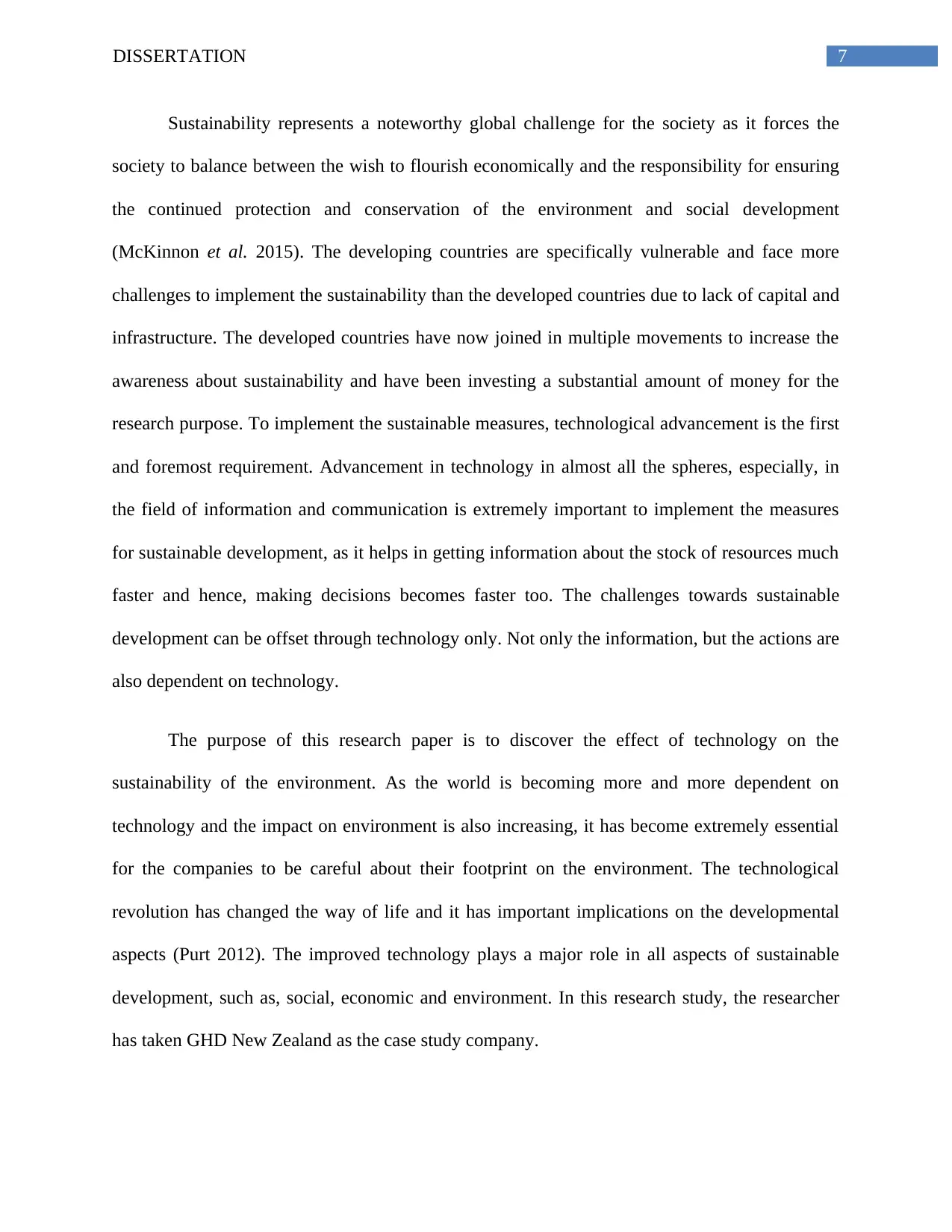
7DISSERTATION
Sustainability represents a noteworthy global challenge for the society as it forces the
society to balance between the wish to flourish economically and the responsibility for ensuring
the continued protection and conservation of the environment and social development
(McKinnon et al. 2015). The developing countries are specifically vulnerable and face more
challenges to implement the sustainability than the developed countries due to lack of capital and
infrastructure. The developed countries have now joined in multiple movements to increase the
awareness about sustainability and have been investing a substantial amount of money for the
research purpose. To implement the sustainable measures, technological advancement is the first
and foremost requirement. Advancement in technology in almost all the spheres, especially, in
the field of information and communication is extremely important to implement the measures
for sustainable development, as it helps in getting information about the stock of resources much
faster and hence, making decisions becomes faster too. The challenges towards sustainable
development can be offset through technology only. Not only the information, but the actions are
also dependent on technology.
The purpose of this research paper is to discover the effect of technology on the
sustainability of the environment. As the world is becoming more and more dependent on
technology and the impact on environment is also increasing, it has become extremely essential
for the companies to be careful about their footprint on the environment. The technological
revolution has changed the way of life and it has important implications on the developmental
aspects (Purt 2012). The improved technology plays a major role in all aspects of sustainable
development, such as, social, economic and environment. In this research study, the researcher
has taken GHD New Zealand as the case study company.
Sustainability represents a noteworthy global challenge for the society as it forces the
society to balance between the wish to flourish economically and the responsibility for ensuring
the continued protection and conservation of the environment and social development
(McKinnon et al. 2015). The developing countries are specifically vulnerable and face more
challenges to implement the sustainability than the developed countries due to lack of capital and
infrastructure. The developed countries have now joined in multiple movements to increase the
awareness about sustainability and have been investing a substantial amount of money for the
research purpose. To implement the sustainable measures, technological advancement is the first
and foremost requirement. Advancement in technology in almost all the spheres, especially, in
the field of information and communication is extremely important to implement the measures
for sustainable development, as it helps in getting information about the stock of resources much
faster and hence, making decisions becomes faster too. The challenges towards sustainable
development can be offset through technology only. Not only the information, but the actions are
also dependent on technology.
The purpose of this research paper is to discover the effect of technology on the
sustainability of the environment. As the world is becoming more and more dependent on
technology and the impact on environment is also increasing, it has become extremely essential
for the companies to be careful about their footprint on the environment. The technological
revolution has changed the way of life and it has important implications on the developmental
aspects (Purt 2012). The improved technology plays a major role in all aspects of sustainable
development, such as, social, economic and environment. In this research study, the researcher
has taken GHD New Zealand as the case study company.
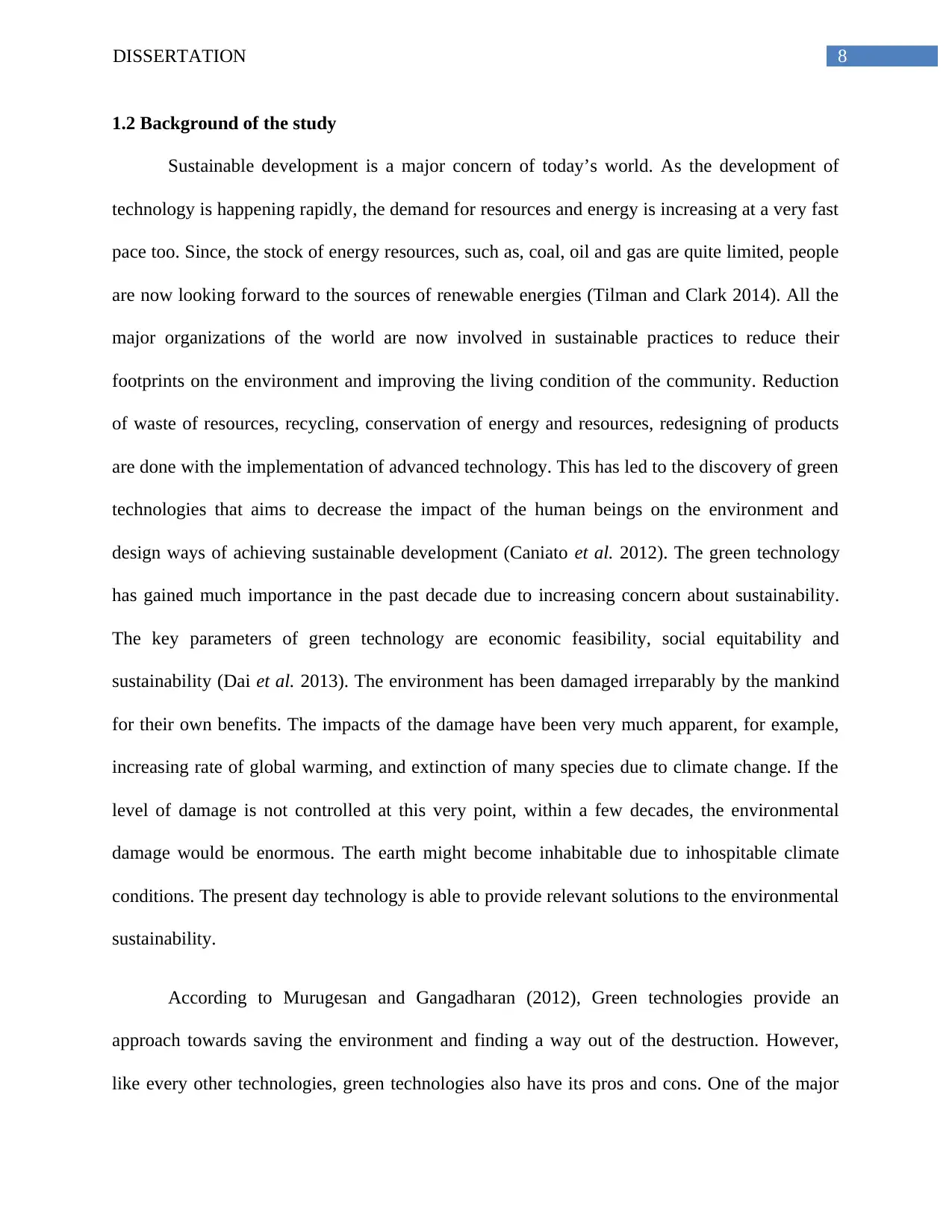
8DISSERTATION
1.2 Background of the study
Sustainable development is a major concern of today’s world. As the development of
technology is happening rapidly, the demand for resources and energy is increasing at a very fast
pace too. Since, the stock of energy resources, such as, coal, oil and gas are quite limited, people
are now looking forward to the sources of renewable energies (Tilman and Clark 2014). All the
major organizations of the world are now involved in sustainable practices to reduce their
footprints on the environment and improving the living condition of the community. Reduction
of waste of resources, recycling, conservation of energy and resources, redesigning of products
are done with the implementation of advanced technology. This has led to the discovery of green
technologies that aims to decrease the impact of the human beings on the environment and
design ways of achieving sustainable development (Caniato et al. 2012). The green technology
has gained much importance in the past decade due to increasing concern about sustainability.
The key parameters of green technology are economic feasibility, social equitability and
sustainability (Dai et al. 2013). The environment has been damaged irreparably by the mankind
for their own benefits. The impacts of the damage have been very much apparent, for example,
increasing rate of global warming, and extinction of many species due to climate change. If the
level of damage is not controlled at this very point, within a few decades, the environmental
damage would be enormous. The earth might become inhabitable due to inhospitable climate
conditions. The present day technology is able to provide relevant solutions to the environmental
sustainability.
According to Murugesan and Gangadharan (2012), Green technologies provide an
approach towards saving the environment and finding a way out of the destruction. However,
like every other technologies, green technologies also have its pros and cons. One of the major
1.2 Background of the study
Sustainable development is a major concern of today’s world. As the development of
technology is happening rapidly, the demand for resources and energy is increasing at a very fast
pace too. Since, the stock of energy resources, such as, coal, oil and gas are quite limited, people
are now looking forward to the sources of renewable energies (Tilman and Clark 2014). All the
major organizations of the world are now involved in sustainable practices to reduce their
footprints on the environment and improving the living condition of the community. Reduction
of waste of resources, recycling, conservation of energy and resources, redesigning of products
are done with the implementation of advanced technology. This has led to the discovery of green
technologies that aims to decrease the impact of the human beings on the environment and
design ways of achieving sustainable development (Caniato et al. 2012). The green technology
has gained much importance in the past decade due to increasing concern about sustainability.
The key parameters of green technology are economic feasibility, social equitability and
sustainability (Dai et al. 2013). The environment has been damaged irreparably by the mankind
for their own benefits. The impacts of the damage have been very much apparent, for example,
increasing rate of global warming, and extinction of many species due to climate change. If the
level of damage is not controlled at this very point, within a few decades, the environmental
damage would be enormous. The earth might become inhabitable due to inhospitable climate
conditions. The present day technology is able to provide relevant solutions to the environmental
sustainability.
According to Murugesan and Gangadharan (2012), Green technologies provide an
approach towards saving the environment and finding a way out of the destruction. However,
like every other technologies, green technologies also have its pros and cons. One of the major
⊘ This is a preview!⊘
Do you want full access?
Subscribe today to unlock all pages.

Trusted by 1+ million students worldwide
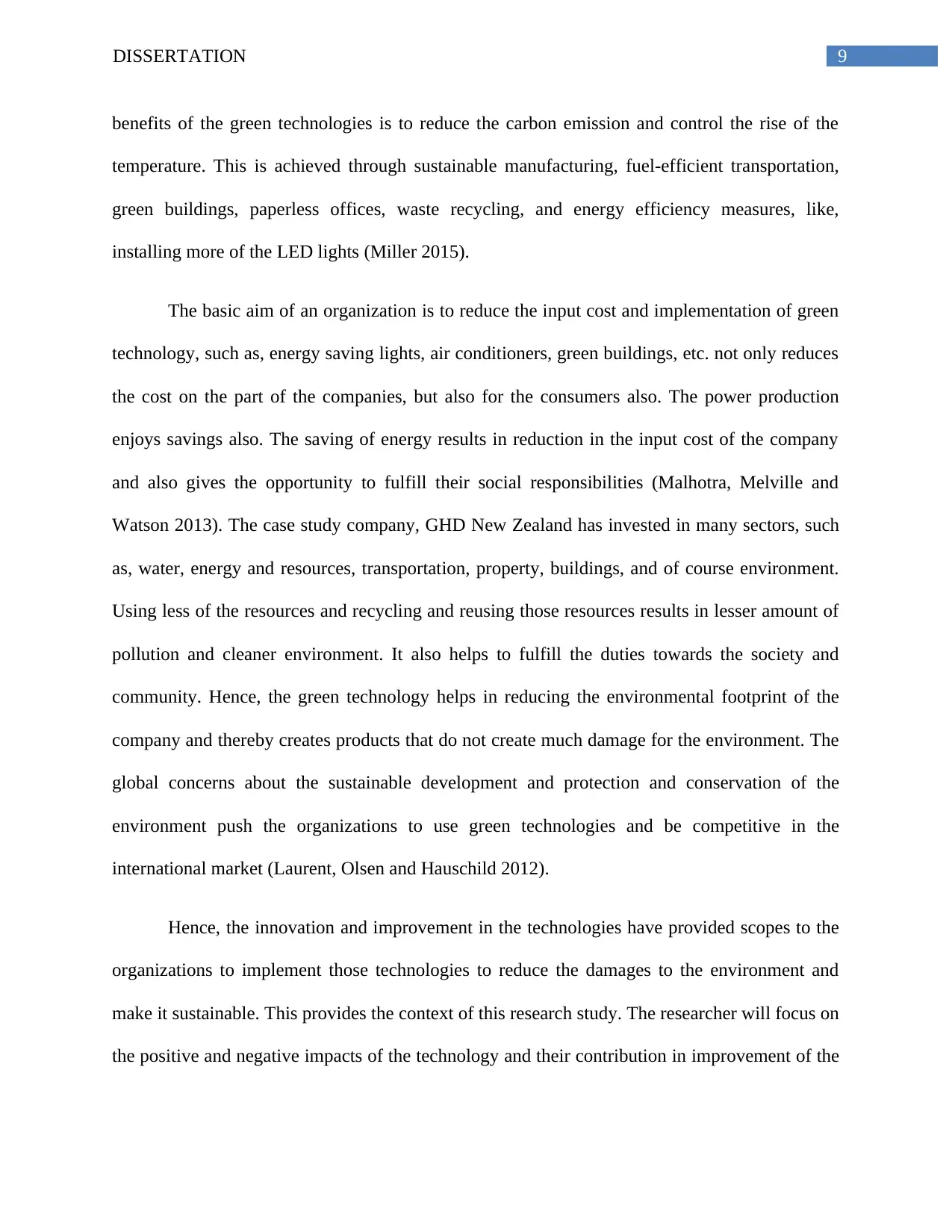
9DISSERTATION
benefits of the green technologies is to reduce the carbon emission and control the rise of the
temperature. This is achieved through sustainable manufacturing, fuel-efficient transportation,
green buildings, paperless offices, waste recycling, and energy efficiency measures, like,
installing more of the LED lights (Miller 2015).
The basic aim of an organization is to reduce the input cost and implementation of green
technology, such as, energy saving lights, air conditioners, green buildings, etc. not only reduces
the cost on the part of the companies, but also for the consumers also. The power production
enjoys savings also. The saving of energy results in reduction in the input cost of the company
and also gives the opportunity to fulfill their social responsibilities (Malhotra, Melville and
Watson 2013). The case study company, GHD New Zealand has invested in many sectors, such
as, water, energy and resources, transportation, property, buildings, and of course environment.
Using less of the resources and recycling and reusing those resources results in lesser amount of
pollution and cleaner environment. It also helps to fulfill the duties towards the society and
community. Hence, the green technology helps in reducing the environmental footprint of the
company and thereby creates products that do not create much damage for the environment. The
global concerns about the sustainable development and protection and conservation of the
environment push the organizations to use green technologies and be competitive in the
international market (Laurent, Olsen and Hauschild 2012).
Hence, the innovation and improvement in the technologies have provided scopes to the
organizations to implement those technologies to reduce the damages to the environment and
make it sustainable. This provides the context of this research study. The researcher will focus on
the positive and negative impacts of the technology and their contribution in improvement of the
benefits of the green technologies is to reduce the carbon emission and control the rise of the
temperature. This is achieved through sustainable manufacturing, fuel-efficient transportation,
green buildings, paperless offices, waste recycling, and energy efficiency measures, like,
installing more of the LED lights (Miller 2015).
The basic aim of an organization is to reduce the input cost and implementation of green
technology, such as, energy saving lights, air conditioners, green buildings, etc. not only reduces
the cost on the part of the companies, but also for the consumers also. The power production
enjoys savings also. The saving of energy results in reduction in the input cost of the company
and also gives the opportunity to fulfill their social responsibilities (Malhotra, Melville and
Watson 2013). The case study company, GHD New Zealand has invested in many sectors, such
as, water, energy and resources, transportation, property, buildings, and of course environment.
Using less of the resources and recycling and reusing those resources results in lesser amount of
pollution and cleaner environment. It also helps to fulfill the duties towards the society and
community. Hence, the green technology helps in reducing the environmental footprint of the
company and thereby creates products that do not create much damage for the environment. The
global concerns about the sustainable development and protection and conservation of the
environment push the organizations to use green technologies and be competitive in the
international market (Laurent, Olsen and Hauschild 2012).
Hence, the innovation and improvement in the technologies have provided scopes to the
organizations to implement those technologies to reduce the damages to the environment and
make it sustainable. This provides the context of this research study. The researcher will focus on
the positive and negative impacts of the technology and their contribution in improvement of the
Paraphrase This Document
Need a fresh take? Get an instant paraphrase of this document with our AI Paraphraser
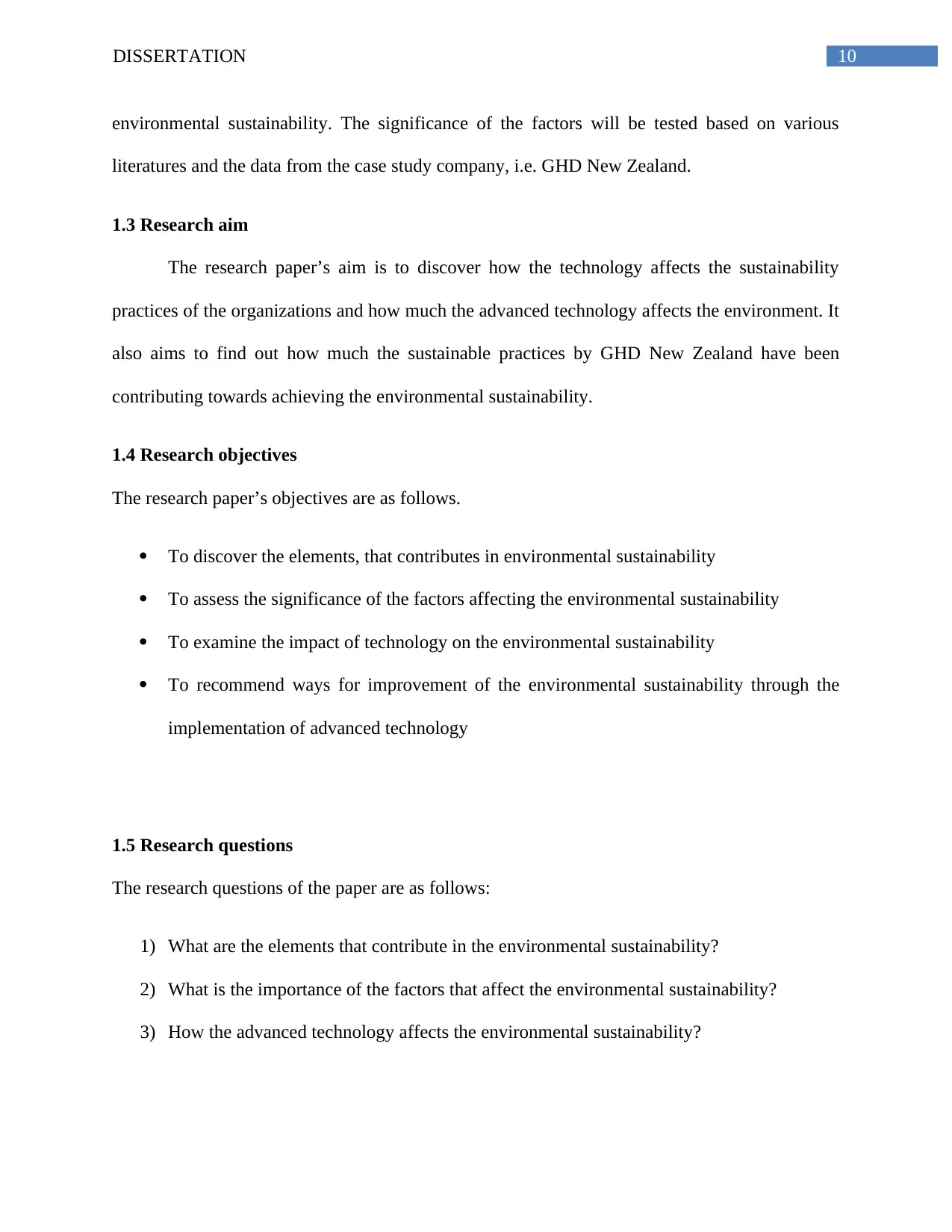
10DISSERTATION
environmental sustainability. The significance of the factors will be tested based on various
literatures and the data from the case study company, i.e. GHD New Zealand.
1.3 Research aim
The research paper’s aim is to discover how the technology affects the sustainability
practices of the organizations and how much the advanced technology affects the environment. It
also aims to find out how much the sustainable practices by GHD New Zealand have been
contributing towards achieving the environmental sustainability.
1.4 Research objectives
The research paper’s objectives are as follows.
To discover the elements, that contributes in environmental sustainability
To assess the significance of the factors affecting the environmental sustainability
To examine the impact of technology on the environmental sustainability
To recommend ways for improvement of the environmental sustainability through the
implementation of advanced technology
1.5 Research questions
The research questions of the paper are as follows:
1) What are the elements that contribute in the environmental sustainability?
2) What is the importance of the factors that affect the environmental sustainability?
3) How the advanced technology affects the environmental sustainability?
environmental sustainability. The significance of the factors will be tested based on various
literatures and the data from the case study company, i.e. GHD New Zealand.
1.3 Research aim
The research paper’s aim is to discover how the technology affects the sustainability
practices of the organizations and how much the advanced technology affects the environment. It
also aims to find out how much the sustainable practices by GHD New Zealand have been
contributing towards achieving the environmental sustainability.
1.4 Research objectives
The research paper’s objectives are as follows.
To discover the elements, that contributes in environmental sustainability
To assess the significance of the factors affecting the environmental sustainability
To examine the impact of technology on the environmental sustainability
To recommend ways for improvement of the environmental sustainability through the
implementation of advanced technology
1.5 Research questions
The research questions of the paper are as follows:
1) What are the elements that contribute in the environmental sustainability?
2) What is the importance of the factors that affect the environmental sustainability?
3) How the advanced technology affects the environmental sustainability?
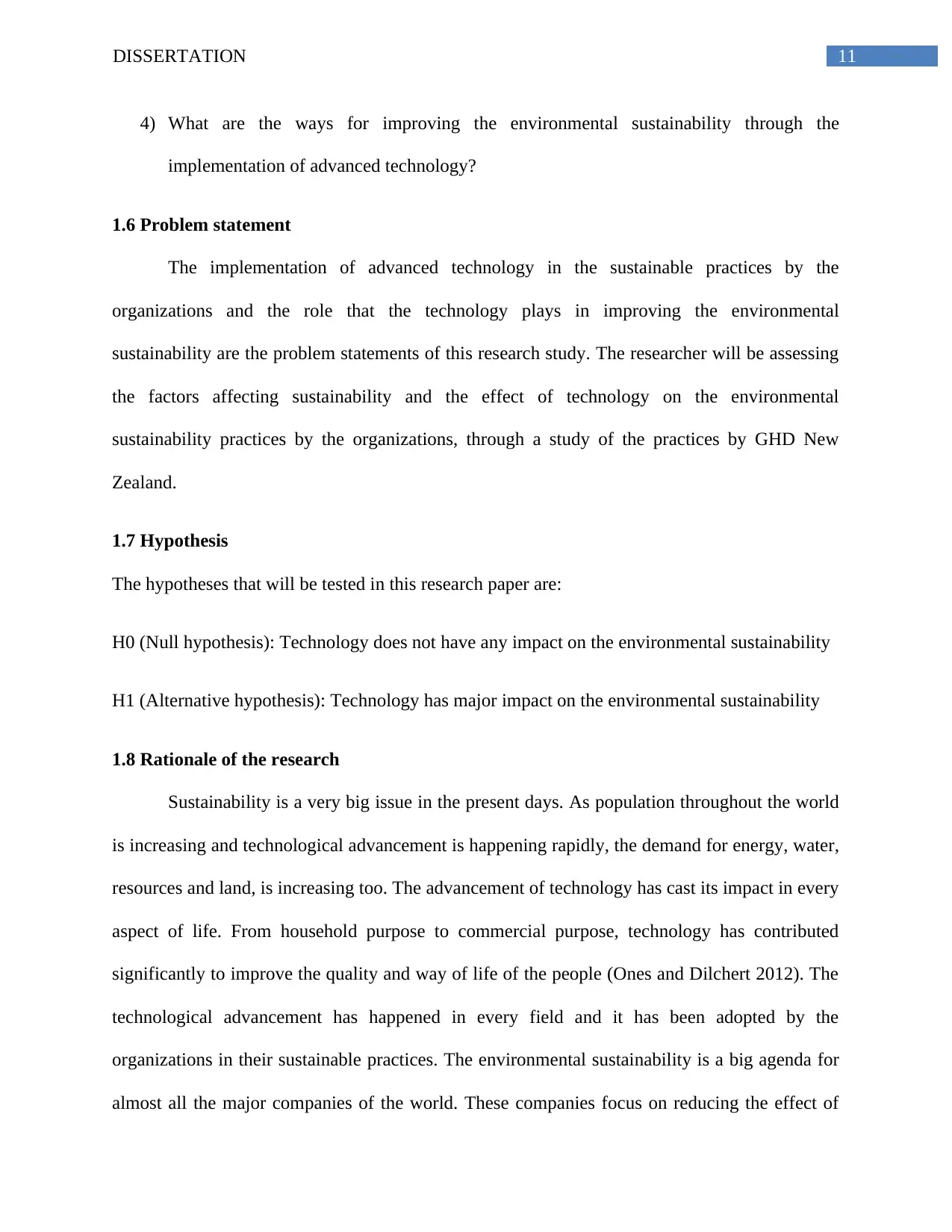
11DISSERTATION
4) What are the ways for improving the environmental sustainability through the
implementation of advanced technology?
1.6 Problem statement
The implementation of advanced technology in the sustainable practices by the
organizations and the role that the technology plays in improving the environmental
sustainability are the problem statements of this research study. The researcher will be assessing
the factors affecting sustainability and the effect of technology on the environmental
sustainability practices by the organizations, through a study of the practices by GHD New
Zealand.
1.7 Hypothesis
The hypotheses that will be tested in this research paper are:
H0 (Null hypothesis): Technology does not have any impact on the environmental sustainability
H1 (Alternative hypothesis): Technology has major impact on the environmental sustainability
1.8 Rationale of the research
Sustainability is a very big issue in the present days. As population throughout the world
is increasing and technological advancement is happening rapidly, the demand for energy, water,
resources and land, is increasing too. The advancement of technology has cast its impact in every
aspect of life. From household purpose to commercial purpose, technology has contributed
significantly to improve the quality and way of life of the people (Ones and Dilchert 2012). The
technological advancement has happened in every field and it has been adopted by the
organizations in their sustainable practices. The environmental sustainability is a big agenda for
almost all the major companies of the world. These companies focus on reducing the effect of
4) What are the ways for improving the environmental sustainability through the
implementation of advanced technology?
1.6 Problem statement
The implementation of advanced technology in the sustainable practices by the
organizations and the role that the technology plays in improving the environmental
sustainability are the problem statements of this research study. The researcher will be assessing
the factors affecting sustainability and the effect of technology on the environmental
sustainability practices by the organizations, through a study of the practices by GHD New
Zealand.
1.7 Hypothesis
The hypotheses that will be tested in this research paper are:
H0 (Null hypothesis): Technology does not have any impact on the environmental sustainability
H1 (Alternative hypothesis): Technology has major impact on the environmental sustainability
1.8 Rationale of the research
Sustainability is a very big issue in the present days. As population throughout the world
is increasing and technological advancement is happening rapidly, the demand for energy, water,
resources and land, is increasing too. The advancement of technology has cast its impact in every
aspect of life. From household purpose to commercial purpose, technology has contributed
significantly to improve the quality and way of life of the people (Ones and Dilchert 2012). The
technological advancement has happened in every field and it has been adopted by the
organizations in their sustainable practices. The environmental sustainability is a big agenda for
almost all the major companies of the world. These companies focus on reducing the effect of
⊘ This is a preview!⊘
Do you want full access?
Subscribe today to unlock all pages.

Trusted by 1+ million students worldwide
1 out of 67
Related Documents
Your All-in-One AI-Powered Toolkit for Academic Success.
+13062052269
info@desklib.com
Available 24*7 on WhatsApp / Email
![[object Object]](/_next/static/media/star-bottom.7253800d.svg)
Unlock your academic potential
Copyright © 2020–2025 A2Z Services. All Rights Reserved. Developed and managed by ZUCOL.





